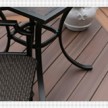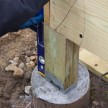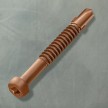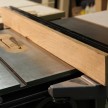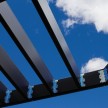Choosing The Best Fence And Deck Materials
Choosing Material For Outdoor Projects:

Image: Sudburycedar.com
If you’ve been staring at your tired or failing deck this summer and wish you could replace it, but are unsure where to start. This brief tutorial will get your outdoor project off the ground. Whether you want to build a deck, repair an existing porch, or want to add privacy to your property with a fence you first need to determine your materials.
We’ll focus on the right material for your needs and arm you with critical details to make an informed decision. Once you’ve reviewed this article you can walk the aisles of Home Depot with the confidence to choose the right material for you and your home.
First and foremost let’s talk about wood. Regardless if you decide to go with a composite material for decking or fencing, your framing and posts will most likely be composed of pressure treated wood material or PT. Any outdoor projects you tackle should be built using this wood that has been treated with chemicals that resists fungus, bacteria, and insects. Additionally, it is applied in a pressure chamber, so these chemicals are forced into the core of the wood.
Some other important abbreviations you’ll need to know when considering material for outdoor structures are SPF, DWLD, and PVC:
Generic wood material is labeled SPF meaning spruce, pine, or fir, which indicates that piece of wood or fence section can be composed of either spruce, pine, or fir. The characteristics of these species of wood are similar enough that they can be interchanged with no impact to performance. Here in New England the Eastern White Pine is king, most often when you purchase a SPF labeled material it will be Eastern White Pine.
When considering purchasing wood fencing sections you’ll have a lot of options to choose from, one you’ll see is sections labeled DWLD, which means doweled. A dowel is used to join two separate pieces of wood together, and with fencing, the ends of the rails of each section extends beyond the pickets allowing that section to be inserted into pockets in the posts. This method adds strength to your fence as each section is “joined” to the next, instead of relying on mechanical fasteners (nails or screws).
Finally, you’ll see PVC which isn’t wood at all, but a composite plastic. Most people are familiar with this product, but what you may not know is that it is becoming more and more popular with carpenters and builders beyond fencing and decking. PVC is the common abbreviation of Polyvinyl Chloride, which is a plastic that has been widely used to create durable, long lasting, and low maintenance building materials.
Choosing Decking Material
Now, let’s discuss your options for decking. The most common decking material is PT, from the framing to the rails this material is affordable, durable, and just about every builder is familiar with it and can build you a product you’ll love. PT will still require some maintenance over time and the green tint of the wood, a bi-product of the chemical treatment, may not give you the aesthetics you’re looking for. If you plan on painting or staining your deck this is a great option.
Looking for no maintenance? Composite decking is the way to go, but you’ll have to pay for it up front. The options for PVC decking and railing are more and more diverse which will allow you to create a beautiful deck or porch with little to no maintenance required. (Just a power wash from time to time) But this maintenance free lifestyle comes with a cost and usually the more elaborate the design, the higher the expense. Additionally, the cost of trim pieces and accessories can push your budget sky-high, so if you’re looking at this option do yourself a favor and pay close attention to every detail in your design so you don’t overlook expensive components. The saving grace of PVC is usually that installation is faster, which can save you on labor costs, or if you’re doing it yourself, save you time.
Personally I prefer the look of a natural wood deck, like Fir or Mahogany. Fir is considered a softwood, but is often used on covered decks, but still requires treatment and maintenance. Fir has a elegant straight grain and is light brown in color. Mahogany is a hardwood and has natural properties that resist rot and insects. Mahogany is a dark wood with dense grain and although it can withstand the elements, it should be treated to maintain its rich color and will ensure your deck stays beautiful for years. These deck boards are usually 1 by 4, compared to PT or PVC boards which are usually 1-1/4″ by 6, giving your deck a look of hardwood flooring. In fact you may see these wood decking options called outdoor flooring, versus decking.
Natural wood will always provide a beautiful look and although may require more maintenance and higher installation costs, it will be competitive pricing wise compared to composite materials. When considering material selection, if you live in a coastal community, you’ll want to err on the side of caution as your outdoor structures will be exposed to high winds, salt water, and more frequent changes in humidity which can wreak havoc on your deck or fence. So invest in quality materials now or you’ll end up wasting money repairing or replacing your structures later.
Choosing Fencing Material
Finally, let’s talk fencing material. We’ve already discussed DWLD and you’ll see this option on most wood fencing material, but like decks there are plenty of PVC options and some composite materials covered with stone like finishes.
Similar to decking, the cost spectrum is very much the same, starting with your most affordable options like treated, but not pressure treated, SPF. Pressured treated SPF is often the next most expensive, then add some cost if you get DWLD sections, and finally the thickness of the fence will change the price as well.
Another wood option in fencing, is Cedar, White Cedar is most common in New England and it has natural properties that resist insects and rot, but you can also find Red Cedar or other Redwoods, of course these are the most expensive wood options, but provide a beautiful aesthetic for your landscape.
Additionally, Cedar is easy to work with and is best for any type of board or picket fence – as long as the bottom of the fence is not continually touching the ground. Cedar is a very stable wood. It does not warp, shrink, or check (as pressure treated Pine most likely will do eventually). Depending on the quality, PT Pine boards can warp and shrink as quickly as one month after installation, so remember not all PT is of the same quality, and with building material the old adage holds true, “you get what you pay for”.
A fence using Cedar boards will have a much nicer appearance after 10 years compared to a pressure treated Pine board fence. Although Cedar lumber costs more than the fast-grown Southern Yellow Pine, Cedar fencing can last 30 years or more and will stay straight. Personally I prefer the look of natural wood and love working with Cedar, so the cost is well worth it.
Again if you don’t have time for maintenance and want to go with a composite remember the costs can be high, and unfortunately installation time isn’t much faster. But as I mentioned before, if you live in a coastal community and need to ensure your fence will withstand the abuse of the ocean winds and weather PVC or other composites may make sense for you.
Now that you’re familiar with your outdoor material options for your deck or fence, check out some of the styles and prices on the Home Depot’s Lumber and Composites section of their website. Don’t let another summer go by and miss another year of enjoyment on your new deck. And to ensure your neighbors won’t be jealous of all your outdoor fun make your yard private with a new fence!



